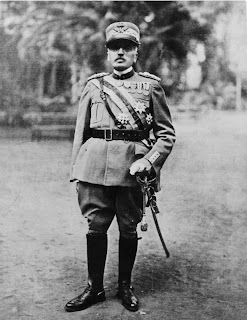Nonetheless, General Cadorna adopted an offensive strategy. The primary focus would be concentrated against the Austrians and Cadorna planned for a succession of “lunges” along the Isonzo River. In the first year of Italian participation in the war, General Cadorna launched four of these “lunge” offensives on the Isonzo line with the goal of capturing Gorizia from which the Italian armies could threaten Trieste or the Austrian heart of the Austrian homeland. Cadorna based this strategy on the understanding that the bulk of Austrian strength would be occupied by the hard-fighting Serbians, leaving the Italian frontier lightly defended. However, the Austrians enjoyed a strong defensive position along the mountainous border and were better equipped than the Italian army which had only 300 machine guns of quality design when the first troops charged into the Austrian lines. The result was a horrific casualty rate in exchange for only minor territorial gains. Attack after attack yielded similar, meager results. The character of General Cadorna also made it very difficult to adjust tactics to say nothing of considering an overall change in strategy.
As soon as the war began, Count Cadorna became known as an intolerant authoritarian. He disliked the almost constant presence of His Majesty King Vittorio Emanuele III at the front, he tore up messages from the Prime Minister in Rome and was notorious for dismissing any subordinates who disagreed with his strategy or voiced opposition to his plans. During his time in command, General Cadorna dismissed no less than 216 generals, 255 colonels and 355 battalion commanders who disagreed with or otherwise displeased him. His disciplinary measures on the enlisted men were no less harsh with one out of every 17 men being brought up on charges during his tenure, about 750 of whom were executed. Naturally, this greatly damaged the cohesion of the army and dangerously lowered the morale of the soldiers. However, Cadorna refused to ever consider that he might be in the wrong and anyone who suggested that the great losses and lack of a major victory were his fault would soon find themselves in a prison cell. That was for the officers. The other ranks were less fortunate. When offensives fell short of their goals, Cadorna blamed the soldiers and even reintroduced the old Roman punishment of decimation in an effort to “motivate” them.
 |
| Cadorna with his staff officers |
The breaking point came in October 1917 when the Austrians, reinforced by a number of crack German divisions, launch a major offensive against Caporetto (today Kobarid in Slovenia). The Italian forces were shattered, with a few exceptions and the army almost completely came apart. Hundreds of thousands were taken prisoner, tens of thousands were killed and hundreds of thousands simply panicked. They had been taken by surprise due to a heavy mist on the opening day of the attack and the German had made heavy use of poison gas which the Italians lacked an effective defense against. A massive retreat followed to the Piave River where the Italian army began to put itself back together and where the Allies, belatedly, rushed in assistance. General Cadorna had retreated as well but, as usual, refused to accept responsibility for the disaster and placed the blame on his soldiers. The Allied leaders came together to discuss the situation and King Vittorio Emanuele III proved a zealous and passionate defender of the ordinary Italian fighting man against those who would demean his courage and integrity. Since the King dispelled that myth, there could be no question that General Cadorna had to be replaced.
The former commander was replaced by General Armando Diaz and General Cadorna was “kicked upstairs” to be the Italian representative at the Allied Supreme War Council in Versailles. A new strategy was adopted and the Italian army effected an almost miraculous recovery. Cadorna, however, remained bitter about his dismissal and after the war spent his time writing his version of events in which he, typically, blamed everyone but himself for the misfortunes Italian arms had suffered. He had an exaggerated sense of his own importance and at the start of the war liked to envision himself as another Napoleone. When he was dismissed he believed that the public would rise up on his behalf and not allow it to happen but, after Caporetto, no one was sorry to see him go and he bitterly blamed the House of Savoy for forcing him into retirement in a last act of shameless indiscipline and bad grace. A post-war enquiry showed the extent of his mistakes as well as his flight to Padua, abandoning the second army, at the height of the disaster. Although retired, Mussolini gave him the honorary rank of Marshal of Italy in 1924 and he died in Bordighera in 1928, still a bitter man.






No comments:
Post a Comment